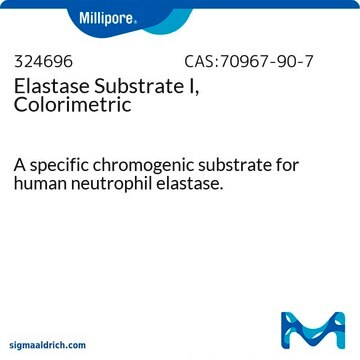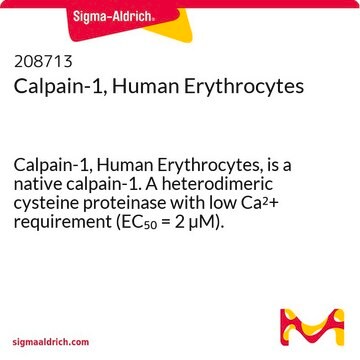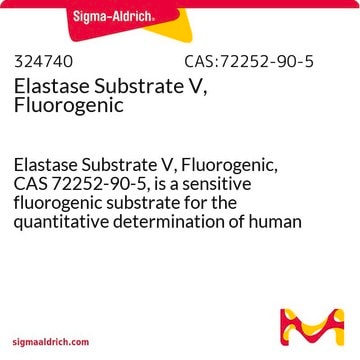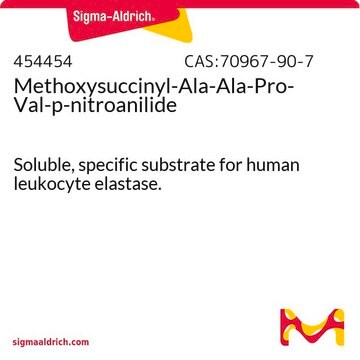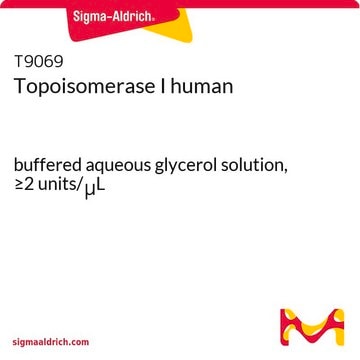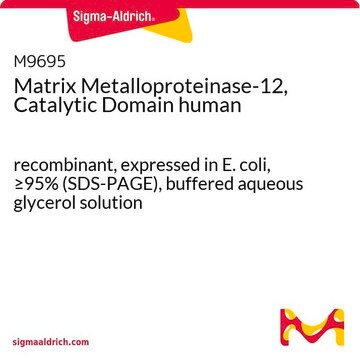This form of neutrophil elastase is a salt-free preparation and is supplied in an active form with a specific activity of ≥20 units/mg protein. It is not sterile and has not been tested for cell culture applications. To use it in a cell culture assay, sterile filtration is necessary, which may result in some product retention on the filter.
324681
Elastase, Human Neutrophil
Elastase, Human Neutrophil, CAS 9004-06-2, is a serine protease that degrades elastin, collagen, and proteoglycans
Sinónimos:
Elastase, Human Neutrophil
Seleccione un Tamaño
401,00 €
Seleccione un Tamaño
About This Item
401,00 €
Productos recomendados
Nivel de calidad
descripción
Merck USA index - 14, 3535
Formulario
lyophilized solid
actividad específica
≥20 units/mg protein
fabricante / nombre comercial
Calbiochem®
condiciones de almacenamiento
OK to freeze
Condiciones de envío
ambient
temp. de almacenamiento
−20°C
Descripción general
Advertencia
Definición de unidad
Forma física
Nota de preparación
Reconstitución
Nota de análisis
Otras notas
Junger, W.G., et al. 1992. Biol. Chem. Hoppe-Seyler 373, 691.
Selak, M.A. 1992. Thromb. Haemost.68, 570.
Baugh, R.J., and Travis, J. 1976. Biochemistry15, 836.
Información legal
Palabra de señalización
Danger
Frases de peligro
Consejos de prudencia
Clasificaciones de peligro
Eye Irrit. 2 - Resp. Sens. 1 - Skin Irrit. 2 - STOT SE 3
Órganos de actuación
Respiratory system
Código de clase de almacenamiento
11 - Combustible Solids
Clase de riesgo para el agua (WGK)
WGK 3
Punto de inflamabilidad (°F)
Not applicable
Punto de inflamabilidad (°C)
Not applicable
Certificados de análisis (COA)
Busque Certificados de análisis (COA) introduciendo el número de lote del producto. Los números de lote se encuentran en la etiqueta del producto después de las palabras «Lot» o «Batch»
¿Ya tiene este producto?
Encuentre la documentación para los productos que ha comprado recientemente en la Biblioteca de documentos.
Los clientes también vieron
-
Hi Is this form of neutrophil elastase active and suitable be used directly in a cell assay? And is it sterile ? Mvh Magdalena
1 respuesta-
¿Le ha resultado útil?
-
-
Has this product been tested for the presence of endotoxin?
1 respuesta-
Unfortunately, this product has not been tested for the presence for endotoxins
¿Le ha resultado útil?
-
-
what is the molecular wight of the enzyme ?
1 respuesta-
Unfortunately, the molecular weight has not been determined for this product. A number of estimates have been reported in the literature. Please see the link below to a publication that may be helpful:
https://www.sciencedirect.com/science/article/pii/S1016847823175091?via%3Dihub¿Le ha resultado útil?
-
-
Is this the active form of the enzyme? or does it require activation by cathepsin?
1 respuesta-
Here are the recommended reconstitution and reaction conditions:
Solubility information:
Reconstitute in 50 mM sodium acetate, pH 5.5, with 200 mM NaCl or in other aqueous buffers. Material is most active near a neutral pH, but to maintain stability upon reconstitution, use in a slightly acidic buffer (pH 5.5) to avoid autolysis.
Following reconstitution, aliquot and freeze (-20°C) for long term storage or refrigerate (4°C) for short-term storage. Acidic stock solutions are stable for up to 1 month at 4°C or for up to 1 year at -20°C.Human Neutrophil Elastase Protocol
1. Dissolve enzyme in reaction buffer: 100 mM Tris-HCl, pH 7.5, 500 mM NaCl.
2. Prepare the substrate stock solution by dissolving Elastase Substrate I (MeOSuc-Ala-Ala-Pro-Val-pNA, Cat. No. 324696) at 50 mM in DMSO.
3. Just prior to assay, dilute the substrate stock solution with an equal volume of 200 mM Tris-HCl, pH 8.0. Mix well.
4. Prepare the assay mixture by combining 960 µl of reaction buffer with 40 µl of diluted substrate stock solution.
5. Add enzyme to assay mixture, mix, and incubate at 25°C.
6. Monitor the change in absorbance at 410 nm. Use an ε of 8800 at 410 nm to calculate the hydrolysis of nitroanilide.¿Le ha resultado útil?
-
Filtros activos
Nuestro equipo de científicos tiene experiencia en todas las áreas de investigación: Ciencias de la vida, Ciencia de los materiales, Síntesis química, Cromatografía, Analítica y muchas otras.
Póngase en contacto con el Servicio técnico
